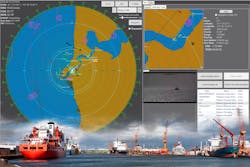Software design tools that help designers blend shipboard radar and video introduced by Cambridge Pixel
CAMBRIDGE, England – Cambridge Pixel in Cambridge, England, is introducing the Maritime Display Framework (MDF) software design tools to enable maritime integrators to speed development of automatic radar plotting aid (ARPA) radar display consoles.
The software provides a .NET framework, optionally with source code, that designers can use as the starting point for a custom shipboard application that displays primary radar, radar tracks, S-57/S-63 electronic navigational charts, secondary transponder information like AIS and ADS-B, and NMEA navigation data.
The MDF software can receive video from radar by Furuno, Hensoldt, JRC, Koden, Raymarine, Raytheon, Simrad, Sperry, and Terma, with control of the radar supported for certain models.
The MDF software supports bearing lines, range markers, trails, closest point of approach, time to closest point of approach. It also supports camera video to integrate radar and camera display for security against piracy and smugglers.
The MDF software is compatible with Cambridge Pixel's radar processing products, such as SPx Server for target tracking and SPx Fusion. The Maritime Display Framework is written in the C# language and is designed for development of a Windows WPF-based client application.
For more information contact Cambridge Pixel online at www.cambridgepixel.com.

